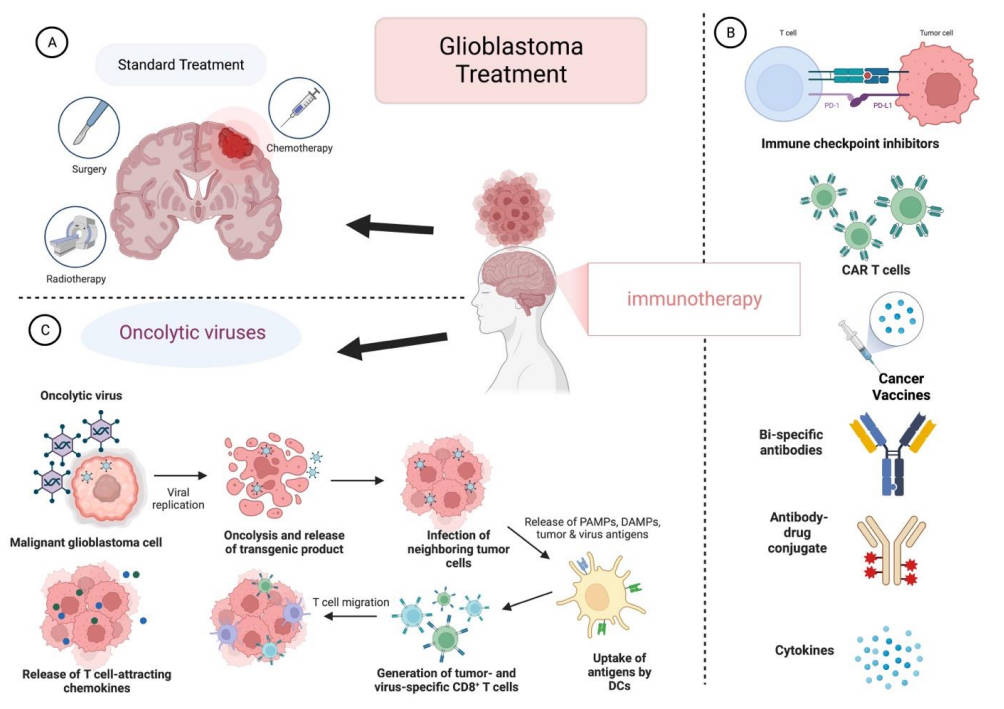Creative Biolabs is an indubitable global leader of the in vitro diagnostics (IVD) antibodies market. With an accumulation of experiences in IVD antibodies development and manufacture, we are dedicated to providing a broad range of services for glioblastoma diagnosis.
Glioblastoma (GBM) is the most common and aggressive primary brain tumor in adults, accounting for 16% of primary malignant brain tumors and nervous system neoplasms. Its histopathologic features are necrosis and endothelial proliferation, resulting in the assignment of the highest grade (grade IV) in the World Health Organization (WHO) classification of brain tumors. Although almost all the GBMs occur exclusively in the brain, they are also found in the brain stem, cerebellum, and spinal cord. The survival rate is related to the age: 5% of the patients diagnosed with glioblastoma are alive five years later, and this measure declines to 2% among patients around 65 years.
GBM could be classified as primary GBM and secondary GBM. The primary GBM arises without a known precursor while the secondary GBM is the one where the low-grade tumor transforms into GBM over time. The majority of GBMs are primary and they tend to be older and have a poorer prognosis than the patients with secondary GBMs. Due to the development of genomic profiling and the Cancer Genome Atlas project, more than 600 genes derived from over 200 human tumor samples were sequenced, which unravels the genetic profile of GBM and three signaling pathways, including the tumor protein p53 pathway, the receptor tyrosine kinase/Ras/phosphoinositide 3-kinase and the retinoblastoma pathway. Alterations have been found in these pathways from both primary and secondary GBMs. These alterations give rise to the uncontrolled cell proliferation and allow the escape of the tumor cells from cell-cycle checkpoints.
 Fig.1 GB treatment types.1
Fig.1 GB treatment types.1
Risk factors
Although a lot of efforts have been put into identifying specific associations of GBM with environmental and occupational exposure, there' s still more to be done on what exactly the risk factors are. GBM is associated with some specific genetic diseases such as neurofibromatosis 1 and 2, tuberous sclerosis, Li-Fraumeni syndrome, retinoblastoma, and Turcot syndrome. Lonizing radiation is reported to be one of the few known risk factors that show an increased risk of glioma development. Smoking, pesticides, petroleum refining and rubber manufacturing are all associated with GBM.
Diagnostic
When viewed with Magnetic resonance imaging (MRI), GBMs often appear as ring-enhancing lesions or masses with contrast enhancement at their margin as a correlate of blood-brain barrier disruption. As other lesions such as abscess, metastasis, tumefactive multiple sclerosis, and other entities may have a similar appearance. A stereotactic biopsy or a craniotomy with tumor resection and pathologic confirmation is required for the definitive diagnosis of a suspected GBM on CT or MRI.
It is worth noting that the tumor grade is based upon the most malignant portion of the tumor, biopsy or subtotal tumor resection can result in undergrading of the lesion. Using perfusion MRI to image tumor blood flow and measuring tumor metabolite concentration with MR spectroscopy aid in standard MRI in select cases by showing increased relative cerebral blood volume and increased choline peak respectively, but most importantly, pathology remains the gold standard for diagnosis and molecular characterization.
The primary GBMs develop rapidly de novo. It is usually found in elderly patients and shows no histologic evidence of a less malignant precursor lesion. Secondary glioblastomas progress from low-grade diffuse astrocytoma or anaplastic astrocytoma. They are usually found in younger patients. They have a lesser degree of necrosis and are preferentially located in the frontal lobe, and carry a significantly better prognosis
It is of great importance to distinguish primary GBM from secondary GBM. They have the different prognosis, different tumor biology and may have a different response to therapy. These are factors that impact the critical evaluation to determine patient prognosis and therapy. IDH1 mutations are the earliest detectable genetic alteration in secondary GBM, suggesting that IDH1 mutations are a useful tool to distinguish primary and secondary GBMs.
Creative Biolabs provides a full range of IVD antibodies development services for GBM diagnosis. Please feel free to contact us for more information and a detailed quote.
Biomarker available now for GBM diagnosis:
|
EGFR VIII |
miR-9 |
miR-25 |
miR-23 |
miR-330 |
miR-31 |
|
miR-10b |
miR-15a |
miR-16 |
miR-23a |
miR-137 |
miR-7 |
|
miR-23b |
miR-204 |
miR-222 |
miR-221 |
miR-124 |
miR-483-5p |
|
miR-125b |
miR-92 |
miR-28 |
miR-24 |
miR-128 |
miR-885-5p |
|
miR-328 |
miR-19a |
miR-451 |
miR-145 |
miR-34a |
miR-491-5p |
|
miR-106a |
miR-410 |
miR-15b |
miR-152 |
miR-101 |
miR-634 |
|
miR-195 |
miR-633 |
miR-136 |
miR-148 |
miR-32 |
|
Reference
- Hamad, Azzam, et al. "Recent developments in glioblastoma therapy: oncolytic viruses and emerging future strategies." Viruses 15.2 (2023): 547. Distributed under Open Access license CC BY 4.0, without modification.
For Research Use Only.

